Aeroacoutics of rotating surfaces
PublicationsObjective
- Understanding of aerodynamic noise generation mechanisms involving solid surfaces
Methodology
- Development of analytical models for broadband and tonal noise generation and propagation
- Design of academic experiments for acoustic sources characterization and model validation
- Assessment of noise reduction techniques
Invited professors
- Vladimir Golubev, Associate Professor, Embry-Riddle University, Feb.- June 2011
- Soichi Sasaki, Assistant Professor, Nagasaki University, Mar. - Sept 2011
Some illustrations
- Analytical model for the tonal noise of open rotors
- Airfoil broadband noise reduction techniques
- Aerodynamic, aeroacoustic & aeroelastic fan optimization
- Analytical & numerical methods for fan broadband noise modeling
- Fan aeroacoustic characterization
Analytical model for the tonal noise of open rotors
Snapshot of the unsteady loading on a propeller blade
due to an incoming sinusoidal gust, obtained from analytical computation.The surface is divided in 15 trapezoidal segments. Arnulfo Carazo & Michel Roger collaboration with Airbus |
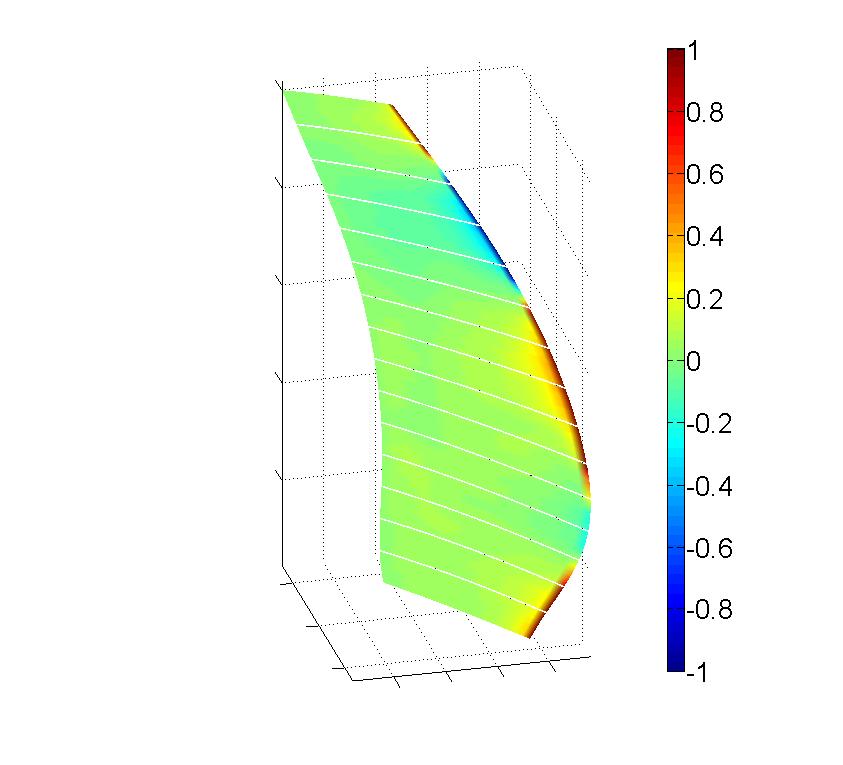
|
The impingement of a velocity distortion on a rigid airfoil will induce a pressure fluctuation on its surface, in order to balance the momentum fluctuation in the fluid around it. The particular case of a sinusoidal distortion interacting with a thin airfoil was addressed by Amiet under the assumption of slight camber and angle of attack. The original formulation stands for a flat airfoil of infinite extent in the span-wise direction and with parallel leading and trailing edges, interacting with a sinusoidal gust perpendicular to its surface.
A theory extension, currently under development at LMFA, allows the introduction of an airfoil sweep (leading to parallelogram-shaped airfoils) and chord variation with the span (leading to trapezoid-shaped airfoils). These features are commonly found in devices as Prop-Fans, Couter-rotation Propelers and some turbomachinery stages.
 |
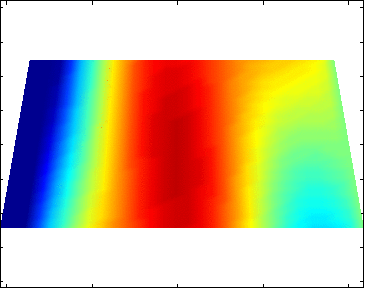 |
| Unsteady loading of a parallelogram |
Unsteady loading of a trapezoid |
For comparison, the animations show the unsteady loading due to the interaction of an oblique gust parallel to the leading-edge of a parallelogram (left) and a trapezoid (right). These different loading distributions will induce different acoustic fields.
Airfoil broadband noise reduction techniques
Trailing edge serrations on a linear cascade
Picture of the experimental set-upThe engine rotor is unrolled and the blades are bolt in 2 wooden plates. Arthur Finez & Marc Jacob,FLOCON european project |
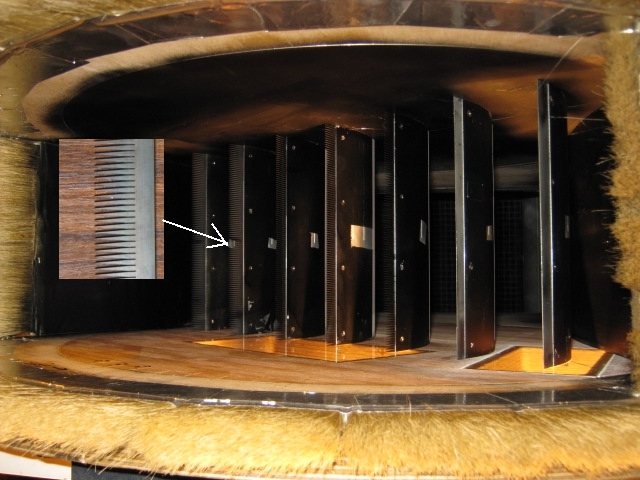
|
Broadband trailing edge noise is a matter of concern in modern turbofan engines. In order to reduce it, very thin serrations are inserted in the trailing edge of compressor blades. The noise reduction potential of such passive devices is assessed in a dedicated experiment, where the rotor is replaced by a non-moving linear cascade. A quiet flow coming at 300km/h is ducted through the cascade, generating the same acoustic sources than in a real engine. A microphone located in the anechoic room records the acoustic far field pressure, while aerodynamic unsteady measurements are undertaken near the trailing edges.

Serrations applied to the trailing edges are found to reduce the broadband noise in extend of 5dB on a wide frequency range and for various flow velocities, without dramatic impact on aerodynamic performances.
Aerodynamic, aeroacoustic & aeroelastic fan optimization
Two optimized airfoil shapesBenoit Marinus & Michel Rogercollaboration with Royal Academy Military of Belgium This research integrates aerodynamics, aeroacoustics and aeroelasticity in an automated, multi-objective and multi-point optimization procedure. The optimization parameters are innovative in order to explore new shapes for transonic aircraft propeller blades. The optimization rests upon evolutionary techniques with two levels of fidelity. |

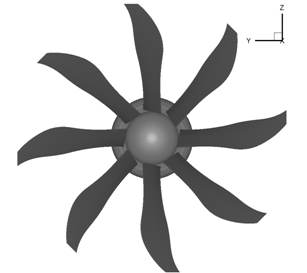
|
Analytical & numerical methods for fan broadband noise modeling
Broadband Scattering of the Incoming Turbulence Noise of a Stationary Airfoil
Figure 1. Experimental jet-airfoil mock-up.a) front view, b) side view Korcan Kucukcoskun & Michel Roger collaboration with Von Karman Institute for Fluid Dynamics & LMS International.This study is a part of the european project ECOQUEST. |
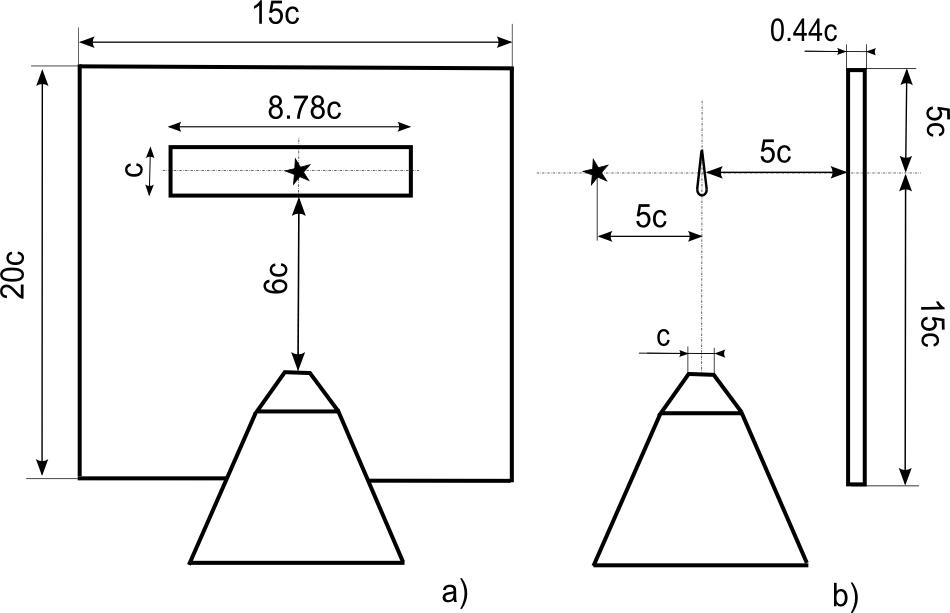
|
Model based on Amiet's theory for incoming turbulence noise with the following extensions:
- A spanwise geometrical near-field correction
- Accounting for the spanwise varying incoming flow conditions with segmentation techniques
- Combination with the Acoustic Transfer Vector (ATV) approach for the broadband scattering.
Testcase: A stationary airfoil is located in the development region of a turbulent jet including a microphone located geometrical near-field of the airfoil with respect to its span length. A flat scattering screen is introduced in the geometrical near-field of the airfoil but outside of the jet flow (see Figure 1).
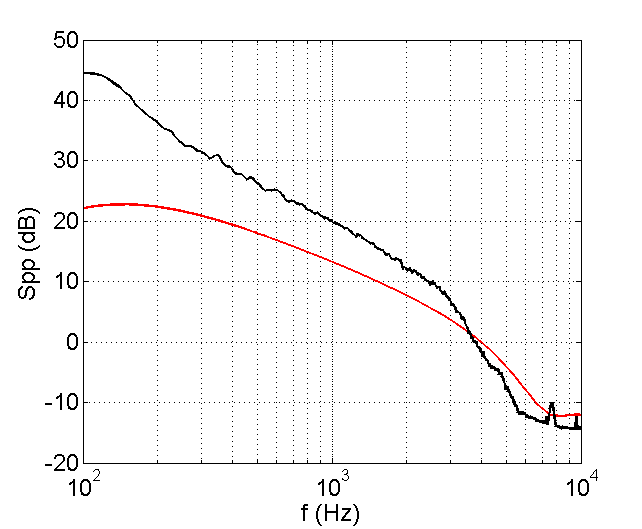
|

|
| Figure 2. Sound power spectra for free (left) and scattered-field (right) configurations. measurements (black) and mathematical models (red). | |
Figure 2 (left) shows the acoustic response of the airfoil in free-field for the given microphone location above. The mathematical model accounts the geometrical near-field correction and 8 spanwise segments using isotropic and homogeneous von Karman turbulence spectrum. Figure (right) shows the acoustic response of the same mock-up including the flat scattering screen. The difference between measurements and mathematical models are not more than 5 dB in the frequencies above 1000 Hz. The disagreement in the low frequencies is due to the strong anisotropic structure of the incoming turbulent jet flow. The effect of the scattering screen is captured accurately in the mathematical model.
Fan aeroacoustic characterization
Aerodynamic and acoustic investigations of a rotor-stator ducted fan used in aircraft cooling unitsMichel Roger,in collaboration with Technofan (Safran Group) & Airbus. The study is aimed at extracting the modal content of the tonal and broadband signatures of the fan, using cross-correlation techniques and a circular array of either flush-mounted microphones or a near-field external antenna. Rotor wake measurements are made using hot-wire anemometry in order to provide input data in analytical noise models. |

|
 |
haut/top |



